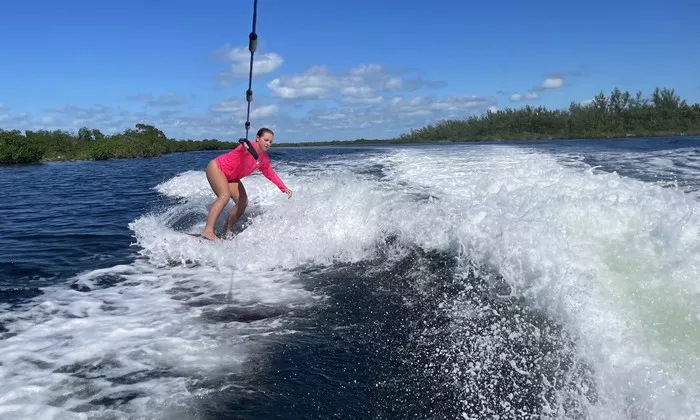In the realm of water sports, few activities offer the adrenaline-pumping thrill and exhilaration of wakeboarding. Combining elements of water skiing, surfing, and snowboarding, wakeboarding has captured the hearts of enthusiasts worldwide. From its humble origins to its status as a mainstream sport, this article explores the essence of wakeboarding, its evolution, techniques, and its growing popularity.
Origins and Evolution
Wakeboarding traces its roots back to the 1980s when it emerged as a fusion of water skiing, surfing, and skateboarding. The sport’s early pioneers experimented with various techniques and equipment, pushing the boundaries of what was possible on the water. Key figures such as Tony Finn, the inventor of the Skurfer, and Herb O’Brien, who introduced the first compression-molded wakeboard, played pivotal roles in shaping wakeboarding into the sport we know today.
As wakeboarding gained momentum, organized competitions began to sprout up, further fueling its growth. The establishment of governing bodies like the World Wakeboard Association (WWA) and the International Waterski & Wakeboard Federation (IWWF) provided a platform for athletes to showcase their skills on a global stage. Today, wakeboarding competitions are held in various formats, including boat, cable, and surf-style events, catering to diverse preferences within the wakeboarding community.
Equipment and Gear
Central to the wakeboarding experience is the equipment and gear used by riders. A typical wakeboard consists of a buoyant board with foot bindings, designed to provide stability and control on the water’s surface. Wakeboards come in various shapes and sizes, each tailored to different riding styles and skill levels.
Boat wakeboarding, the most traditional form of the sport, relies on a speedboat equipped with a tow rope and a wakeboard tower. The tower elevates the tow rope, allowing riders to perform aerial maneuvers with greater ease. In contrast, cable wakeboarding utilizes a system of cables suspended above the water, pulling riders along a predetermined course. This setup offers a more accessible and cost-effective alternative to boat wakeboarding, making it popular among beginners and seasoned riders alike.
Techniques and Tricks
At the heart of wakeboarding are the techniques and tricks that riders perform on the water. From basic maneuvers like carving and jumping to advanced aerial stunts, wakeboarding offers a diverse range of possibilities for riders to explore. Fundamental skills such as edging, or controlling the board’s direction by shifting body weight, form the building blocks for more complex tricks.
Aerial maneuvers, including spins, flips, and grabs, showcase the athleticism and creativity of wakeboarders. Riders launch off the wake created by the boat or cable, executing gravity-defying tricks with precision and style. Variations such as the backside 180, frontside 360, and tantrum exemplify the innovation and progression within the sport, with athletes constantly pushing the boundaries of what is achievable on the water.
Safety and Responsible Riding
While wakeboarding offers an exhilarating experience, safety should always remain a top priority for riders. Proper equipment, including a well-fitted life jacket and helmet, is essential to minimize the risk of injury on the water. Additionally, riders should familiarize themselves with local regulations and guidelines governing water sports activities, ensuring compliance with safety protocols and etiquette.
Beyond individual responsibility, fostering a culture of respect and consideration among wakeboarding communities is crucial for the sport’s long-term sustainability. This includes maintaining awareness of other water users, minimizing environmental impact, and adhering to designated waterways and launch sites. By promoting safety and responsible riding practices, wakeboarding can continue to thrive as a recreational pursuit for generations to come.
The Growing Popularity of Wakeboarding
In recent years, wakeboarding has experienced a surge in popularity, attracting enthusiasts of all ages and backgrounds. Its appeal lies not only in the adrenaline rush of performing daring tricks but also in the sense of camaraderie and community fostered among riders. Whether bonding with friends on the lake or competing in professional tournaments, wakeboarding offers a unique blend of excitement and camaraderie that keeps participants coming back for more.
Furthermore, advancements in technology have contributed to the accessibility and inclusivity of the sport. Innovations such as wake-shaping systems, which manipulate the size and shape of boat wakes, enable riders to customize their experience based on personal preferences and skill levels. Similarly, the proliferation of cable parks and wakeboard resorts has democratized access to the sport, allowing enthusiasts to pursue their passion in diverse locations around the globe.
Conclusion
Wakeboarding stands as a testament to the boundless creativity and athleticism of water sports enthusiasts worldwide. From its humble beginnings to its current status as a mainstream pastime, wakeboarding continues to captivate riders with its exhilarating blend of skill, style, and camaraderie. As the sport evolves and grows, its enduring appeal promises to inspire new generations of riders to take to the water and experience the thrill of wakeboarding firsthand.

